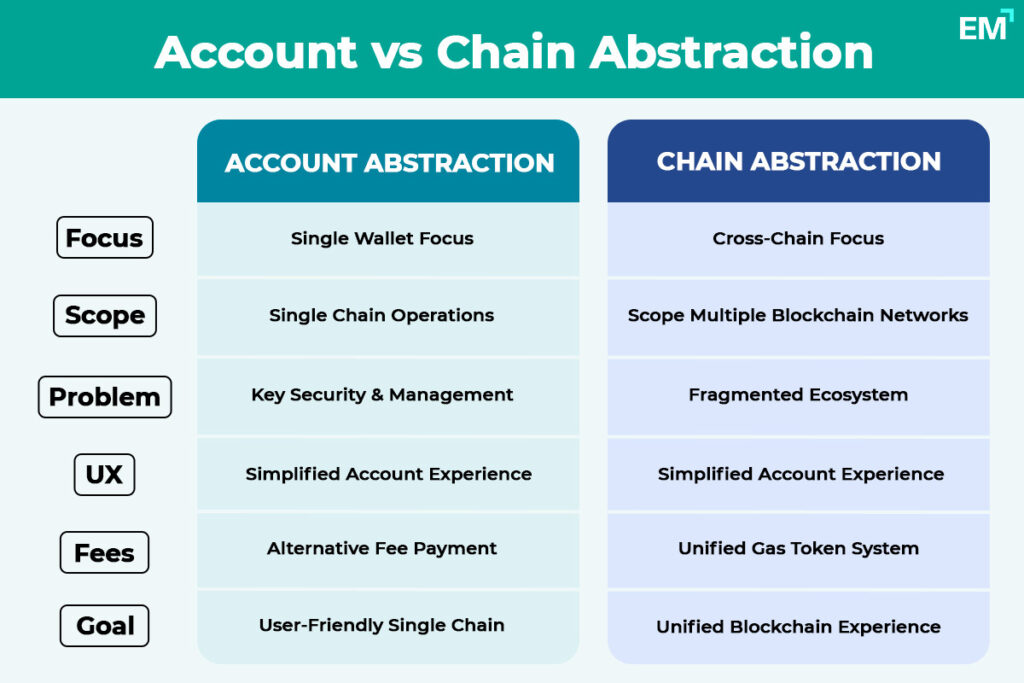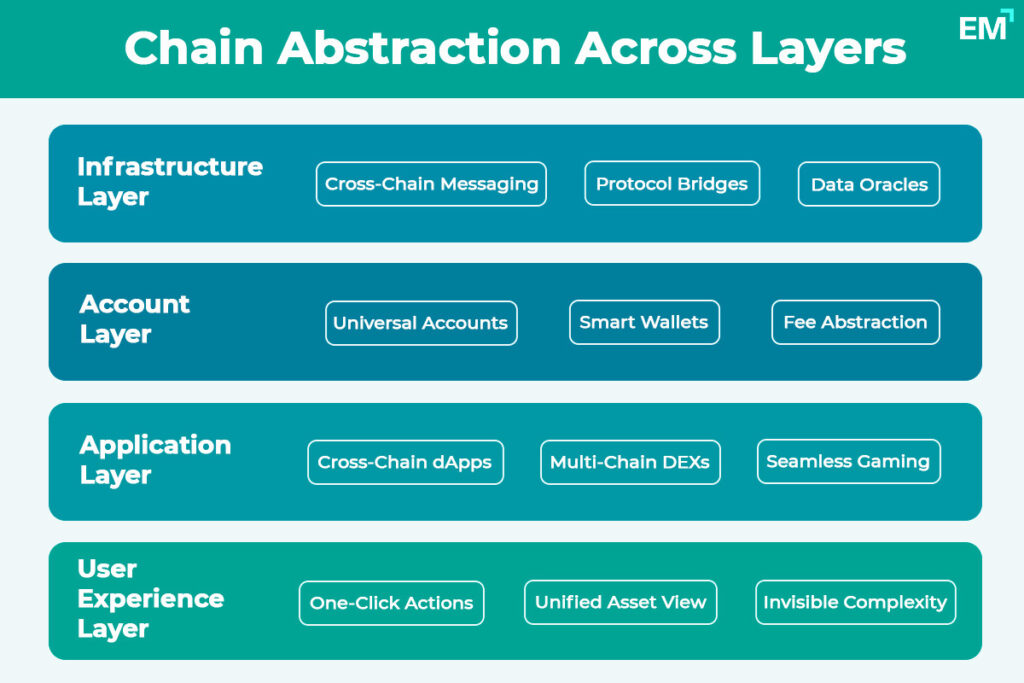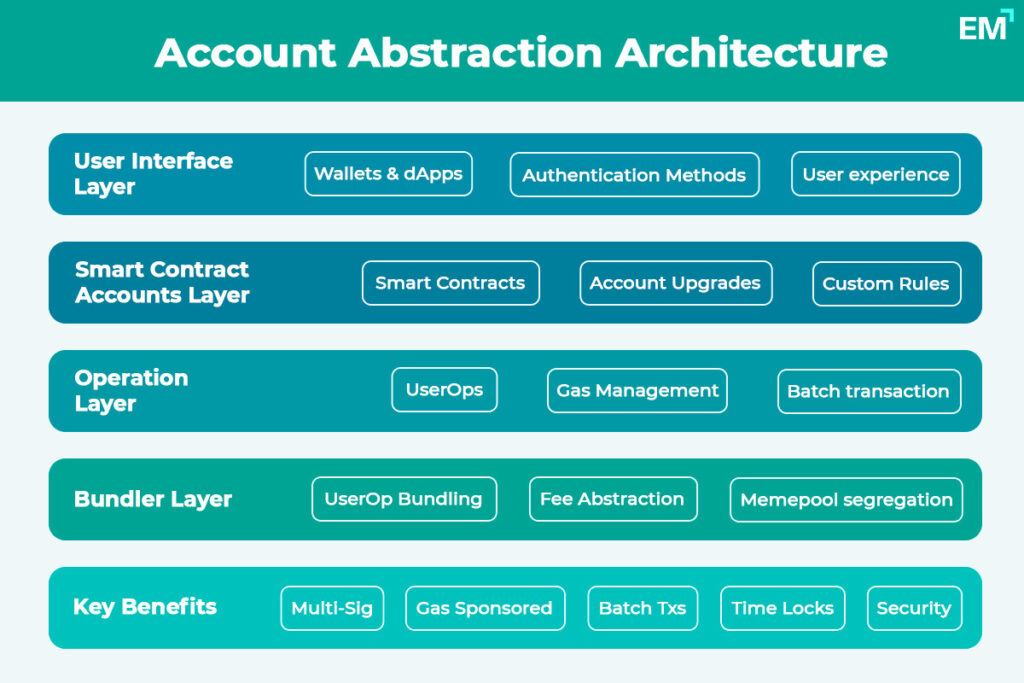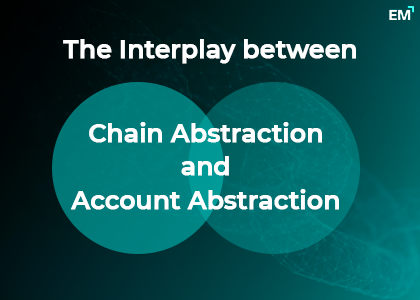Etherspot recently hosted a lively X Space discussion about the future of Account Abstraction (AA) vs. Chain Abstraction (ChA). As these concepts keep evolving, there’s still a lot of confusion around what they do, how they differ, and whether they work against or complement each other.
Both Chain and Account Abstraction aim to solve a bunch of issues for decentralized apps, like the complexity of blockchains, the hassle of token swaps with too many steps, the endless contracts you have to approve, the confusing fees, or even the whole process of dealing with seed phrases, private keys, and gas fees tied to a specific chain. Those who want to navigate the world of Web3 must understand how both technologies work together.
This guide sheds light on the interplay between Chain Abstraction and Account Abstraction.

Ready to amplify your blockchain project’s reach? Emergence Media’s specialized Web3 marketing team understands the complexities of Chain and Account Abstraction. We translate technical innovation into compelling narratives that drive user adoption. Our tailored strategies include content marketing, community building, and strategic partnerships designed specifically for blockchain projects.
Why Do We Need Chain/Account Abstraction?
The Problem Statement: Web3’s User Experience Challenge!
Before diving into the detailed concept of abstractions, let’s identify the core problems they aim to solve.
Today’s blockchain world is fragmented. To perform any transaction on crypto wallet, a user needs to:
- Create multiple crypto wallets.
- Securely store seed phrases.
- Switch between different blockchains to use various applications.
- Manage gas fees in different native tokens.
- Navigate complex technical processes like token bridging.
This fragmentation creates significant entry barriers to the mainstream adoption.
For example, the User may need to download multiple wallets for multichain experiences.
Understanding Chain Abstraction
Chain abstraction represents a fundamental shift in how users and developers interact with blockchain networks. At its core, it’s about creating a seamless experience across multiple blockchains without requiring users to understand the complexity.
What is Chain Abstraction?
Chain abstraction is a layer between applications and different blockchain protocols and allows developers to build applications that can function across multiple networks without extensive code modifications. For users, it means they can interact with various blockchain applications using a single interface without needing to know which specific blockchain they’re using.

Key Benefits of Chain Abstraction
- Improved Scalability
By leveraging multiple chains, applications can handle higher transaction volumes and user loads. For example, a decentralized exchange using chain abstraction could process trades on Ethereum for ERC-20 tokens while simultaneously using Binance Smart Chain for BEP-20 tokens, multiplying its transaction capacity.
- Enhanced Flexibility
Developers can choose the most suitable blockchain for specific tasks within their application. A gaming platform might use Ethereum for secure asset ownership, Polygon for fast and cheap transactions, and Chainlink for reliable external data feeds.
- Future-Proofing
Applications remain viable even if one blockchain network faces issues or becomes obsolete. If Ethereum experiences congestion, a chain-abstracted application can automatically route transactions through alternative networks like Solana or Avalanche.
- Wider User Base
Multi-chain compatibility allows applications to reach users across various blockchain ecosystems simultaneously. A decentralized lending platform could serve users from Ethereum, Binance Smart Chain, and Polkadot communities all at once.
- Unified Liquidity
Chain abstraction enables assets to move freely across chains, creating larger liquidity pools and reducing market slippage. This makes trading more efficient and accessible.
Understanding Account Abstraction
While chain abstraction focuses on unifying the experience across different blockchains, account abstraction addresses how users interact with a blockchain at the wallet level.
What is Account Abstraction?
Account abstraction allows users to use smart contracts as their accounts instead of traditional externally owned accounts (EOAs). This means users can establish their own flexible rules for wallet management, enhancing security and usability.

To understand account abstraction, we need to first understand the traditional blockchain account model:
In the traditional model (EOA), users generate cryptographic key pairs:
- A public key for creating addresses
- A private key for controlling the account
The user must safeguard their private key, and transactions require manual signatures from this key.
With account abstraction, these limitations are overcome by making accounts programmable through smart contracts. This creates possibilities for:
- Social recovery options – allowing trusted contacts to help restore access.
- Customizable security rules – like spending limits or multi-signature requirements.
- Gasless transactions – enabling sponsors to pay for users’ gas fees.
- Scheduled transactions – automating recurring payments or actions.
- Batched transactions – combining multiple operations into one.
The ERC-4337 Standard
The ERC-4337 standard represents the most significant advancement in account abstraction for Ethereum-compatible networks. It enables the creation of programmable smart contract wallets without requiring changes to the underlying blockchain protocol.
This standard introduces several components:
- UserOperation: A new transaction type for smart accounts.
- Bundlers: Entities that collect and process these operations.
- Entry Point Contract: The central smart contract that validates and executes UserOperations.
- Paymasters: Third parties that can sponsor transaction fees.
Struggling to explain complex blockchain concepts to your audience? Emergence Media creates clear, accurate technical content that educates users about innovations like account abstraction. Our team of blockchain writers and marketers bridge the gap between technical complexity and user-friendly messaging, helping you build trust and authority in the Web3 space.
How Chain and Account Abstraction Work Together
While these concepts address different aspects of the blockchain experience, they aren’t competing solutions but complementary technologies that can create powerful synergies when combined.
The Symbiotic Relationship
Chain abstraction needs account abstraction to deliver its full potential. Here’s why:
- Smart Accounts as Foundation
Chain abstraction solutions benefit from the programmable nature of smart accounts. For universal accounts that work across chains, the underlying technology often relies on coordinated smart account deployments across different networks.
- Unified User Identity
Account abstraction provides the foundation for a unified user identity across blockchains. Chain abstraction builds on this to create a seamless multi-chain experience.
- Gas Abstraction
One of the biggest barriers in multi-chain environments is managing gas fees in different native tokens. Account abstraction, through features like paymasters, enables users to pay fees in any token or have fees sponsored entirely.
Real-World Implementation Models
There are several approaches to implementing these abstractions together:
- Account-Level Solutions
Universal accounts coordinate smart contract wallet deployments across multiple chains, giving users a single point of interaction. Users can access their assets and applications on any blockchain without manually switching networks or managing multiple private keys.
- Application-Level (Orchestration) Solutions
These services leverage the programmability of account abstraction to create seamless cross-chain experiences within applications. For example, a decentralized exchange could automatically route trades through the most efficient chain without requiring users to bridge tokens manually.
- Infrastructure-Level Solutions
These focus on creating the underlying technology needed for both abstractions to function efficiently, such as cross-chain messaging protocols and universal identity systems.
The Adoption Journey: Challenges and Progress
Both chain and account abstraction face adoption challenges, but their combined potential is driving innovation across the Web3 ecosystem. These two technologies complement each other to create a smoother, more seamless Web3 experience.
Here’s how:
- AA makes wallets easier to use by simplifying authentication, gas payments, and security.
- ChA takes the complexity out of dealing with multiple blockchains, helping dApps work across chains effortlessly.
Together, they create a world where users can interact with decentralized apps (dApps) without worrying about wallets, gas fees, or switching between networks.
Why Hasn’t Adoption Exploded Yet?
- Technical Complexity
Implementing these abstractions requires significant technical expertise and coordination across different blockchains and protocols.
- Developer Inertia
Many developers have built around the limitations of current systems, and retooling applications for these new paradigms requires investment.
- Fragmented Standards
While ERC-4337 has emerged as a standard for account abstraction, chain abstraction lacks a unified approach, leading to competing implementations.
- Chicken-and-Egg Problem
Users wait for applications to implement these features, while developers wait for user demand to justify the investment.
Recent Progress and Developments
Despite these challenges, significant progress is being made:
- EIP-7702
This new Ethereum Improvement Proposal aims to make account abstraction more accessible by allowing traditional accounts (EOAs) to adopt smart contract features during transactions without requiring users to migrate to entirely new wallets.
- Growing Ecosystem Support
Major players in the blockchain space are developing solutions for both abstraction types:
- Particle Network is working on universal accounts that function across chains.
- Safe (formerly Gnosis Safe) is expanding its smart account capabilities across multiple networks.
- Biconomy is developing infrastructure for account abstraction with cross-chain functionality.
- Near Protocol offers solutions for users to sign transactions on multiple blockchains with a single account.
- Alchemy provides tools for developers to implement these abstractions.
- Increasing Investor Interest
Projects focused on these abstractions are attracting significant venture capital, indicating growing confidence in their long-term potential.
The Abstraction Age
As these technologies mature and converge, we’re entering what some call “The Abstraction Age” in blockchain development. Here’s what this might look like:
For Users
- Invisible Blockchain Technology
Users will interact with applications without needing to understand which blockchain they’re using or managing private keys.
- One Account, All Chains
A single user account will function seamlessly across all compatible blockchains.
- Flexible Payment Options
Users will pay for services in any token they choose, regardless of the blockchain the application runs on.
- Enhanced Security Without Complexity
Advanced security features like multi-signature requirements and spending limits will become standard without adding user friction.
For Developers
- Build Once, Deploy Everywhere
Developers will create applications that automatically function across multiple blockchains.
- Focus on Features, Not Infrastructure
Less time spent on blockchain-specific code means more resources for developing innovative features.
- Expanded User Base
Applications will be accessible to users from any blockchain ecosystem, significantly expanding potential reach.
- Optimized Resource Allocation
Developers can leverage different blockchains’ strengths for different aspects of their applications.
What This Means for Your Business
For businesses considering blockchain, these abstractions offer several advantages:
- Reduced Implementation Complexity
Adopting blockchain technology becomes simpler when the underlying complexity is abstracted away.
- Future-Proof Investment
Solutions built with these abstractions will remain relevant even as the blockchain ecosystem evolves.
- Enhanced User Experience
Removing blockchain-specific friction points makes applications more accessible to mainstream users.
- Expanded Market Opportunities
Access to users across multiple blockchain ecosystems creates larger potential markets.
Getting Started with Abstraction Technologies
If you’re interested in leveraging these technologies, here are some starting points
- Explore Universal Account Solutions
Platforms like Particle Network offer developer tools for implementing universal accounts that work across chains.
- Implement Smart Account Features
Integrate with account abstraction solutions like Safe or Biconomy to enhance your application’s wallet functionality.
- Consider Orchestration Services
Look into services that simplify cross-chain operations for your application, such as Klaster or Near’s solutions.
- Stay Updated on Standards
Follow developments in standards like ERC-4337 and emerging proposals like EIP-7702.
What’s Coming Next? The Future of AA and ChA
Over the next 1–2 years, we’re likely to see:
- Smart wallets are becoming the standard for most Web3 applications.
- EOAs are becoming a thing of the past as dApps adopt AA by default.
- True multi-chain experiences, where users can interact with dApps seamlessly without worrying about chains, liquidity, or bridges.
Ultimately, the combination of Account Abstraction and Chain Abstraction will make Web3 feel as intuitive and user-friendly as Web2, removing the last obstacles to mass adoption.
Take Away
The interplay between chain and account abstraction represents one of the most promising paths to blockchain’s mainstream adoption. By addressing the fundamental user experience challenges that have limited Web3’s growth, these technologies are laying the groundwork for a more accessible, unified, and powerful decentralized ecosystem.
As these abstractions mature and converge, we’re moving toward a future where blockchain technology becomes invisible to the end user – operating seamlessly in the background while providing all the benefits of decentralization, security, and ownership that make Web3 valuable.
For businesses and developers looking to stay ahead of the curve, understanding and implementing these abstractions will be crucial for creating the next generation of successful blockchain applications.
By embracing this “Abstraction Age,” we can collectively build a more user-friendly, efficient, and interconnected blockchain ecosystem that fulfills the original promise of Web3 technology.
From whitepaper development to community management, Emergence Media provides end-to-end marketing for blockchain projects. Our specialized knowledge of account abstraction and smart contract wallets ensures that your marketing resonates with technical audiences while remaining accessible to newcomers. Partner with us to accelerate your growth in the Web3 ecosystem.

